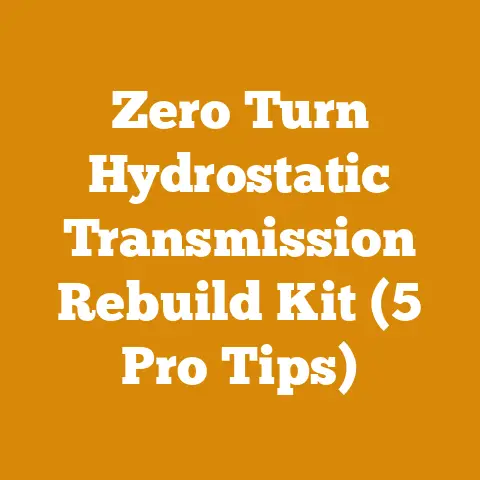48 Chainsaw Repair Tips (Piston Problems & Restoration Guide)
48 Chainsaw Repair Tips (Piston Problems & Restoration Guide)
Understanding the Importance of Chainsaw Maintenance
Chainsaws are powerful tools, but they’re also complex machines that require regular maintenance. Just like a car, neglecting your chainsaw can lead to costly repairs and even dangerous situations. A properly maintained chainsaw is more efficient, safer to use, and lasts longer. Piston problems, in particular, can significantly impact performance and can even cause the engine to seize up entirely.
What is a Piston and Why is it Important?
The piston is a critical component of your chainsaw’s engine. It’s a cylindrical piece that moves up and down inside the cylinder, driven by the combustion of fuel and air. This movement, in turn, drives the crankshaft, which powers the chain. A damaged piston can lead to reduced power, poor fuel efficiency, and eventually, engine failure.
Key Terms & Concepts
- Two-Stroke Engine: Most chainsaws use two-stroke engines, which require a mix of oil and gasoline for lubrication.
- Cylinder: The chamber where the piston moves up and down.
- Piston Rings: Metal rings that seal the piston against the cylinder wall, preventing combustion gases from escaping.
- Combustion Chamber: The area above the piston where the fuel-air mixture is ignited.
- Scoring: Scratches or grooves on the piston or cylinder wall, typically caused by lack of lubrication or debris.
- Seizing: When the piston gets stuck in the cylinder, often due to overheating or lack of lubrication.
- Green Wood: Freshly cut wood with high moisture content.
- Seasoned Wood: Wood that has been dried to reduce its moisture content. Typically, firewood needs to be seasoned for 6-12 months depending on the species and climate.
Diagnosing Piston Problems: The First Steps
Before you start tearing apart your chainsaw, it’s crucial to accurately diagnose the problem. Here are some common symptoms of piston issues:
- Reduced Power: The chainsaw struggles to cut through wood, even with a sharp chain.
- Difficult Starting: The engine is hard to start or refuses to start altogether.
- Unusual Noises: Knocking, rattling, or hissing sounds coming from the engine.
- Excessive Smoke: Blue or black smoke coming from the exhaust, indicating burning oil.
- Poor Fuel Efficiency: The chainsaw consumes more fuel than usual.
- Overheating: The engine gets excessively hot during operation.
Preliminary Checks: Before You Dig Deeper
Before assuming the problem is the piston, perform these basic checks:
- Fuel Quality: Ensure you’re using fresh, properly mixed fuel (typically a 50:1 ratio of gasoline to two-stroke oil). Stale fuel can cause a variety of engine problems.
- Personal Story: I once spent an entire afternoon troubleshooting a chainsaw that wouldn’t start, only to discover the fuel was over a year old!
- Air Filter: A clogged air filter restricts airflow to the engine, leading to reduced power and overheating. Clean or replace the air filter regularly.
- Tip: I recommend cleaning the air filter after every 5-10 hours of use, or more frequently in dusty conditions.
- Spark Plug: A faulty spark plug can cause starting problems and misfires. Check the spark plug for fouling or damage and replace it if necessary.
- Tool Specification: Use a spark plug wrench to remove and install the spark plug. The correct gap for the spark plug is typically specified in the chainsaw’s owner’s manual (usually around 0.020-0.025 inches).
- Exhaust Port: A clogged exhaust port can restrict exhaust flow, leading to reduced power and overheating. Check for carbon buildup and clean the exhaust port if necessary.
- Safety Consideration: Allow the engine to cool completely before inspecting the exhaust port.
Performing a Compression Test
A compression test is a crucial step in diagnosing piston problems. It measures the pressure inside the cylinder, which can indicate the condition of the piston rings and cylinder walls.
- Tools Needed: Compression tester, spark plug wrench.
- Procedure:
- Remove the spark plug.
- Screw the compression tester into the spark plug hole.
- Pull the starter cord several times until the gauge reaches its maximum reading.
- Record the reading.
- Interpreting the Results:
- High Compression (120 PSI or higher): The piston rings and cylinder walls are likely in good condition.
- Low Compression (below 100 PSI): Indicates worn or damaged piston rings, cylinder walls, or both.
- Zero Compression: Indicates a major problem, such as a broken piston or a hole in the cylinder.
Visual Inspection of the Piston
If the compression test indicates a problem, the next step is to visually inspect the piston and cylinder. This requires disassembling the chainsaw.
- Safety First: Disconnect the spark plug wire to prevent accidental starting. Wear gloves and eye protection.
- Disassembly:
- Remove the muffler.
- Remove the cylinder head. This usually involves removing several bolts.
- Carefully inspect the piston and cylinder walls for scoring, cracks, or other damage.
- Tip: Take photos as you disassemble the chainsaw to help you remember how to put it back together.
- Identifying Damage:
- Scoring: Indicates a lack of lubrication or debris in the cylinder.
- Cracks: Can be caused by overheating or excessive stress.
- Broken Piston Rings: Can lead to low compression and poor performance.
- Piston Seizure: The piston is stuck in the cylinder, often due to overheating.
48 Chainsaw Repair Tips: Addressing Piston Problems
Once you’ve diagnosed the piston problem, it’s time to take action. Here are 48 repair tips to help you restore your chainsaw’s performance:
1-10: Cleaning and Inspection Tips
- Clean the Piston: Use carburetor cleaner to remove carbon buildup from the piston.
- Inspect Piston Rings: Check for wear, cracks, and proper tension.
- Clean Ring Grooves: Use a ring groove cleaner to remove carbon deposits from the piston ring grooves.
- Check Cylinder Walls: Look for scoring, cracks, and excessive wear.
- Clean Cylinder: Use carburetor cleaner and a soft cloth to clean the cylinder walls.
- Inspect Cylinder Head: Check for cracks, warping, and damage to the combustion chamber.
- Clean Cylinder Head: Remove carbon buildup from the cylinder head.
- Check Gaskets: Inspect all gaskets for damage and replace them if necessary.
- Clean Gasket Surfaces: Ensure all gasket surfaces are clean and free of debris.
- Inspect Bearings: Check the crankshaft bearings for wear and play.
11-20: Lubrication and Fuel System Tips
- Lubricate the Piston: Apply two-stroke oil to the piston before reassembly.
- Lubricate Cylinder Walls: Apply two-stroke oil to the cylinder walls before reassembly.
- Check Fuel Lines: Inspect fuel lines for cracks, leaks, and deterioration.
- Replace Fuel Lines: Replace any damaged fuel lines.
- Clean Fuel Filter: Clean or replace the fuel filter to ensure a clean fuel supply.
- Check Carburetor: Inspect the carburetor for dirt, debris, and damage.
- Clean Carburetor: Clean the carburetor using carburetor cleaner.
- Adjust Carburetor: Adjust the carburetor settings according to the manufacturer’s specifications.
- Check Fuel Tank: Inspect the fuel tank for cracks and leaks.
- Clean Fuel Tank: Clean the fuel tank to remove any debris or contaminants.
21-30: Ignition and Electrical Tips
- Check Spark Plug Wire: Inspect the spark plug wire for damage and proper connection.
- Replace Spark Plug Wire: Replace the spark plug wire if necessary.
- Check Ignition Coil: Test the ignition coil for proper function.
- Replace Ignition Coil: Replace the ignition coil if necessary.
- Check Flywheel: Inspect the flywheel for damage and proper alignment.
- Clean Flywheel: Clean the flywheel to remove any rust or debris.
- Check Kill Switch: Test the kill switch to ensure it functions properly.
- Repair Kill Switch: Repair or replace the kill switch if necessary.
- Check Wiring: Inspect all wiring for damage and proper connection.
- Repair Wiring: Repair or replace any damaged wiring.
31-40: Assembly and Mechanical Tips
- Proper Assembly: Ensure all parts are assembled correctly according to the manufacturer’s specifications.
- Torque Specifications: Use a torque wrench to tighten all bolts to the correct torque specifications.
- Tool Specification: Refer to the chainsaw’s owner’s manual for torque specifications.
- Check Crankshaft: Inspect the crankshaft for wear and damage.
- Replace Crankshaft: Replace the crankshaft if necessary.
- Check Connecting Rod: Inspect the connecting rod for wear and damage.
- Replace Connecting Rod: Replace the connecting rod if necessary.
- Check Piston Pin: Inspect the piston pin for wear and damage.
- Replace Piston Pin: Replace the piston pin if necessary.
- Check Clutch: Inspect the clutch for wear and damage.
- Replace Clutch: Replace the clutch if necessary.
41-48: General Maintenance and Prevention Tips
- Regular Maintenance: Perform regular maintenance according to the manufacturer’s recommendations.
- Use Correct Fuel Mix: Always use the correct fuel-to-oil ratio (typically 50:1).
- Use High-Quality Oil: Use high-quality two-stroke oil.
- Data Point: Using a synthetic two-stroke oil can reduce carbon buildup and extend engine life.
- Store Chainsaw Properly: Store the chainsaw in a clean, dry place.
- Drain Fuel Before Storage: Drain the fuel tank before storing the chainsaw for extended periods.
- Sharpen Chain Regularly: Keep the chain sharp to reduce engine strain.
- Tip: I sharpen my chainsaws after every 2-3 tanks of fuel.
- Avoid Overloading: Avoid overloading the chainsaw by forcing it to cut through wood that is too thick.
- Listen to Your Chainsaw: Pay attention to any unusual noises or vibrations and address them promptly.
Restoring a Damaged Piston: A Step-by-Step Guide
If your piston is damaged beyond repair, you’ll need to replace it. Here’s a step-by-step guide:
- Gather Your Tools and Materials:
- New piston kit (includes piston, piston rings, piston pin, and circlips)
- Cylinder gasket
- Two-stroke oil
- Carburetor cleaner
- Socket set
- Torque wrench
- Piston ring compressor (optional)
- Remove the Old Piston:
- Disassemble the chainsaw as described earlier.
- Remove the circlips that hold the piston pin in place.
- Push out the piston pin and remove the old piston from the connecting rod.
- Prepare the New Piston:
- Install the new piston rings onto the piston. Use a piston ring compressor if necessary.
- Tip: Make sure the ring gaps are staggered around the piston to prevent leaks.
- Lubricate the piston and piston rings with two-stroke oil.
- Install the new piston rings onto the piston. Use a piston ring compressor if necessary.
- Install the New Piston:
- Align the piston with the connecting rod.
- Insert the piston pin.
- Install the circlips to secure the piston pin.
- Reassemble the Chainsaw:
- Install a new cylinder gasket.
- Carefully slide the cylinder over the piston.
- Tighten the cylinder head bolts to the correct torque specifications.
- Reinstall the muffler.
- Test the Chainsaw:
- Fill the fuel tank with fresh, properly mixed fuel.
- Start the chainsaw and let it idle for a few minutes.
- Check for any leaks or unusual noises.
Case Study: Chainsaw Restoration Project
I once took on a project to restore an old Stihl 026 chainsaw that had been sitting in a barn for years. The piston was heavily scored, and the cylinder walls were damaged. Here’s what I did:
- Disassembly and Inspection: I carefully disassembled the chainsaw and thoroughly inspected all the parts.
- Parts Replacement: I replaced the piston, piston rings, cylinder, and all gaskets.
- Cleaning and Lubrication: I cleaned all the parts with carburetor cleaner and lubricated them with two-stroke oil.
- Reassembly: I reassembled the chainsaw, paying close attention to torque specifications.
- Testing: After reassembly, the chainsaw started on the first pull and ran like new!
This project demonstrated the importance of proper diagnosis, careful disassembly, and thorough reassembly. It also showed that even a heavily damaged chainsaw can be restored to its former glory with the right techniques and parts.
Strategic Advantages of Proper Chainsaw Maintenance
Beyond simply keeping your chainsaw running, proper maintenance offers several strategic advantages:
- Increased Efficiency: A well-maintained chainsaw cuts faster and more efficiently, saving you time and effort.
- Reduced Downtime: Regular maintenance prevents breakdowns and reduces downtime, allowing you to complete your work on schedule.
- Extended Lifespan: Proper maintenance extends the lifespan of your chainsaw, saving you money in the long run.
- Improved Safety: A well-maintained chainsaw is safer to use, reducing the risk of accidents and injuries.
The Role of Hydraulic Splitters
While this guide focuses on chainsaw repair, it’s important to consider the entire wood processing workflow. Hydraulic log splitters play a crucial role in firewood preparation, especially when dealing with large or difficult-to-split logs.
- Increased Efficiency: Hydraulic splitters can split logs much faster and more efficiently than manual methods.
- Data Point: A hydraulic splitter can split a cord of wood in a fraction of the time it takes to split it manually.
- Reduced Strain: Hydraulic splitters reduce the physical strain on the operator, making firewood preparation easier and less tiring.
- Improved Safety: Hydraulic splitters reduce the risk of injury compared to using an axe.
Wood Type Selection and Drying Methods
The type of wood you’re processing and how you dry it also play a significant role in the overall efficiency of your firewood operation.
- Wood Type Selection: Hardwoods like oak, maple, and beech are denser and provide more heat than softwoods like pine and fir.
- Data Point: Oak has a BTU rating of approximately 28 million per cord, while pine has a BTU rating of approximately 20 million per cord.
- Drying Methods: Air drying is the most common method for seasoning firewood. Stack the wood in a well-ventilated area and allow it to dry for 6-12 months. Kiln drying is a faster method, but it’s more expensive.
- Moisture Content Targets: Firewood should have a moisture content of 20% or less for optimal burning.
Safety Considerations
Working with chainsaws and wood processing equipment can be dangerous. Always follow these safety precautions:
- Assess Your Chainsaw: Inspect your chainsaw for any signs of piston problems.
- Perform a Compression Test: Conduct a compression test to determine the condition of the piston rings and cylinder walls.
- Disassemble and Inspect: If necessary, disassemble the chainsaw and visually inspect the piston and cylinder.
- Repair or Replace: Repair or replace any damaged parts.
- Maintain Regularly: Implement a regular maintenance schedule to prevent future problems.
By following these steps, you can keep your chainsaw running smoothly and efficiently for years to come. Remember, a well-maintained chainsaw is not just a tool; it’s an investment in safety, efficiency, and your livelihood. Good luck, and happy cutting!






